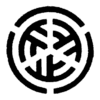Shibuya-machi
| Shibuya-machi (incorporated) 澁 谷 町 |
||
|---|---|---|
|
|
||
| Geographical location in Japan | ||
| Region : | Kanto | |
| Prefecture : | Tokyo | |
| Coordinates : | 35 ° 39 ' N , 139 ° 43' E | |
| Basic data | ||
| Incorporated on: | Oct. 1, 1932 | |
| Incorporated in: | Tokyo | |
| Surface: | ||
| Residents : | 102,056 (October 1, 1930) |
|
| Symbols | ||
| Flag / coat of arms: | ||
| town hall | ||
| Address : |
Shibuya Town Hall Hikawachō Shibuya- machi , Toyotama-gun Tōkyō |
|
Shibuya ( Japanese 澁 谷 町 , Reformed spelling 渋 谷 町 , Shibuya- machi ) was a city (-machi) in the district (-gun) Toyotama of the Japanese prefecture (-fu) Tokyo until 1932 , in the east it bordered on the (independent) City (-shi) Tokyo . It extended into many of the districts in today's Shibuya district , some of which are still very small , including Shibuya - also in the broader colloquial sense as the vicinity of the train station with the exception of the area in the north, which formerly belonged to Sendagaya (see the list of districts in the Tokyo district Shibuya for an enumeration of the current districts, whereby the areas listed there do not correspond in detail with the three predecessor communities due to the new subdivisions of the districts in the 20th century).
history
Through Shibuya at the confluence of the Udagawa in the Shibuyagawa (above the confluence mostly called Ondengawa) ran in the Kamakura period one of the Kamakura kaidō , country roads that emanated from the capital Kamakura . In the Middle Ages, the Shibuya , a branch of the Taira Chichibu family , built Shibuya Castle here , but it was destroyed again by the Hōjō in the 16th century - the older shrine, now called Konnō Hachimangū , where the castle was built, still exists . In the Edo period, Shibuya came increasingly as a suburb in the catchment area of the Shogunate capital Edo , parts of Shibuya were already included in the city. In the Meiji Restoration, the area was divided between the Shinagawa and Tokyo prefectures, and since 1871 it has belonged entirely to the Tokyo prefecture.
From the premodern villages of Kami- ("Upper"), Naka- ("Middle") and Shimo-Shibuya ("Lower Shibuya"; 上 澁 谷 ・ 中 澁 谷 ・ 下 澁 谷 ) in Toshima County (from 1879: South Toshima ) of the ancient province of Musashi , the village community ( mura ) Shibuya ( Shibuya-mura , 澁 谷 村 ) was created with the introduction of today's community forms in 1889 and the associated major Meiji territorial reform . There were also parts of the neighboring, previous urban districts (-ku) Akasaka and Azabu , both of which from then on belonged to the city of Tokyo as districts; conversely, parts of the villages Shimo-Shibuya and Harajuku (otherwise to Sendagaya ) fell to the city of Tokyo. In 1896, South Toshima and East Tama Counties were merged to form Toyotama County. In 1909 Shibuya became a city. After the opening of the Shibuya station on the Shinagawa line in 1885 by Nippon Tetsudō , Shibuya developed into a transport hub with the connection of several suburban railways and soon also became a business center for the rapidly growing Tokyo - today it is one of the three large sub-centers (fukutoshin) in the west Tokyo.
The city of Shibuya - by then it had grown to over 100,000 inhabitants - existed until 1932 when it was incorporated into the city of Tokyo. There, from the previous cities of Shibuya, Sendagaya and Yoyohata, the district (-ku) Shibuya was formed, which became today's "special district" Shibuya after the abolition of the city of Tokyo in 1943 when the Tokyo administration was reorganized under MacArthur in 1947 . The districts of the city of Shibuya had been reorganized in 1928 and were initially taken over into the Shibuya district, in the 1960s they were again fundamentally restructured.
Web links
- Shibuya district: 渋 谷 区 の 歴 史 Shibuya-ku no rekishi , German 'history of the Shibuya district' (Japanese)
- District-operated library Shibuya ( Shibuya-kuritsu Toshokan ): 渋谷区史への扉 Shibuya-kushi e no tobira , German , ~ "gateway to the district History of Shibuya" ' , 渋谷区史年表 Shibuya-kushi nenpyō , German , Chronology of History of Shibuya 'district (Japanese)

